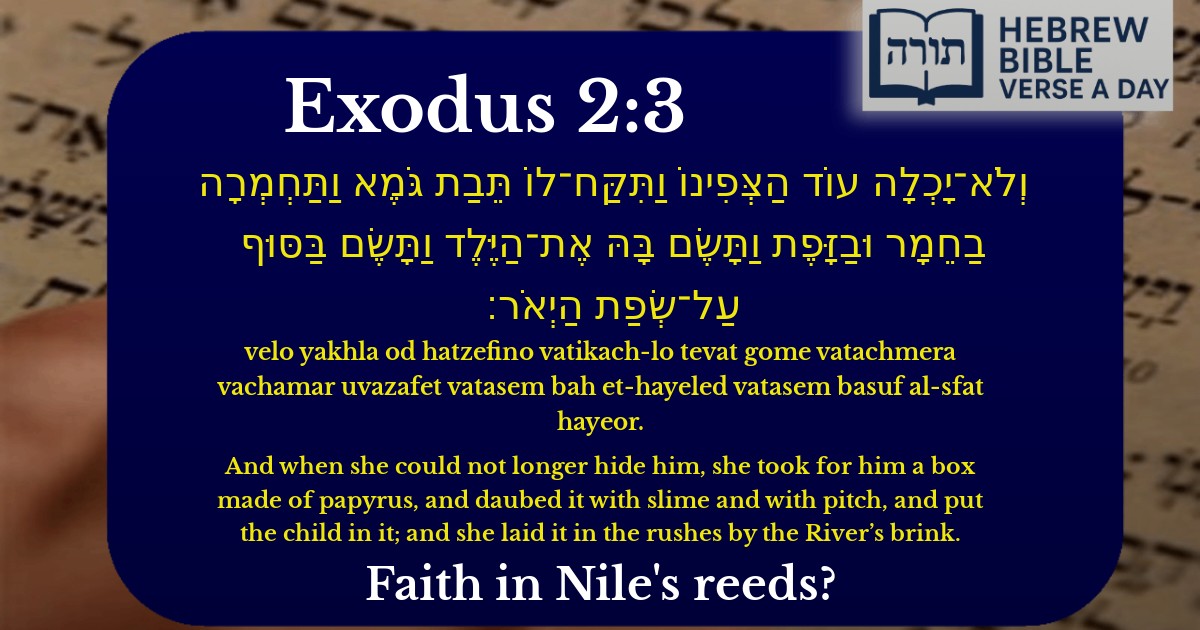Join Our Newsletter To Be Informed When New Videos Are Posted
Join the thousands of fellow Studends who rely on our videos to learn how to read the bible in Hebrew for free!
Hebrew Text
וְלֹא־יָכְלָה עוֹד הַצְּפִינוֹ וַתִּקַּח־לוֹ תֵּבַת גֹּמֶא וַתַּחְמְרָה בַחֵמָר וּבַזָּפֶת וַתָּשֶׂם בָּהּ אֶת־הַיֶּלֶד וַתָּשֶׂם בַּסּוּף עַל־שְׂפַת הַיְאֹר׃
English Translation
And when she could not longer hide him, she took for him a box made of papyrus, and daubed it with slime and with pitch, and put the child in it; and she laid it in the rushes by the River’s brink.
Transliteration
Velo yakhla od hatzefino vatikach-lo tevat gome vatachmera vachamar uvazafet vatasem bah et-hayeled vatasem basuf al-sfat hayeor.
Hebrew Leining Text
וְלֹא־יָכְלָ֣ה עוֹד֮ הַצְּפִינוֹ֒ וַתִּֽקַּֽח־לוֹ֙ תֵּ֣בַת גֹּ֔מֶא וַתַּחְמְרָ֥הֿ בַחֵמָ֖ר וּבַזָּ֑פֶת וַתָּ֤שֶׂם בָּהּ֙ אֶת־הַיֶּ֔לֶד וַתָּ֥שֶׂם בַּסּ֖וּף עַל־שְׂפַ֥ת הַיְאֹֽר׃
וְלֹא־יָכְלָ֣ה עוֹד֮ הַצְּפִינוֹ֒ וַתִּֽקַּֽח־לוֹ֙ תֵּ֣בַת גֹּ֔מֶא וַתַּחְמְרָ֥הֿ בַחֵמָ֖ר וּבַזָּ֑פֶת וַתָּ֤שֶׂם בָּהּ֙ אֶת־הַיֶּ֔לֶד וַתָּ֥שֶׂם בַּסּ֖וּף עַל־שְׂפַ֥ת הַיְאֹֽר׃
🎵 Listen to leining
Parasha Commentary
📚 Talmud Citations
This verse is quoted in the Talmud.
📖 Sotah 12a
The verse is discussed in the context of the story of Moses being placed in the ark by his mother, highlighting the faith and actions of Yocheved (Moses' mother) and the divine protection over Moses.


The Context of the Verse
This verse (Shemot 2:3) describes the actions of Yocheved, Moshe's mother, after she could no longer hide him from Pharaoh's decree to kill all male Hebrew infants. The verse details her efforts to protect Moshe by placing him in a waterproofed basket among the reeds of the Nile River.
Rashi's Commentary
Rashi explains that Yocheved initially hid Moshe for three months (as mentioned in the previous verse) but could no longer conceal him because the Egyptians began searching Jewish homes. He notes that the term "תֵּבַת גֹּמֶא" (a box made of papyrus) implies a lightweight material, suggesting that Yocheved chose it so the basket would float gently rather than sink or be too heavy.
Symbolism of the Materials
Placement Among the Reeds
The Talmud (Sotah 12a) discusses why Yocheved placed the basket specifically "בַסּוּף" (among the reeds). One opinion suggests it was to protect Moshe from the river's currents, while another explains that reeds were a natural hiding place, as they would not attract attention from Egyptian patrols.
Divine Providence
The Ramban (Nachmanides) emphasizes that this act was part of Hashem's plan to save Moshe and ultimately redeem Bnei Yisrael. The seemingly ordinary details—the materials, the location—were all orchestrated to fulfill the divine promise of redemption.